Key takeaways:
- Gender equality advocacy involves recognizing and addressing systemic biases, listening to marginalized voices, and transforming awareness into actionable change.
- Gender equality training fosters inclusive environments by highlighting unconscious biases, creating safe spaces for dialogue, and promoting diverse perspectives.
- Key concepts include the distinction between equity and equality, intersectionality, and the importance of agency in empowering individuals.
- Implementing training lessons in everyday life, such as using inclusive language and actively listening, can create a ripple effect for change in communities.
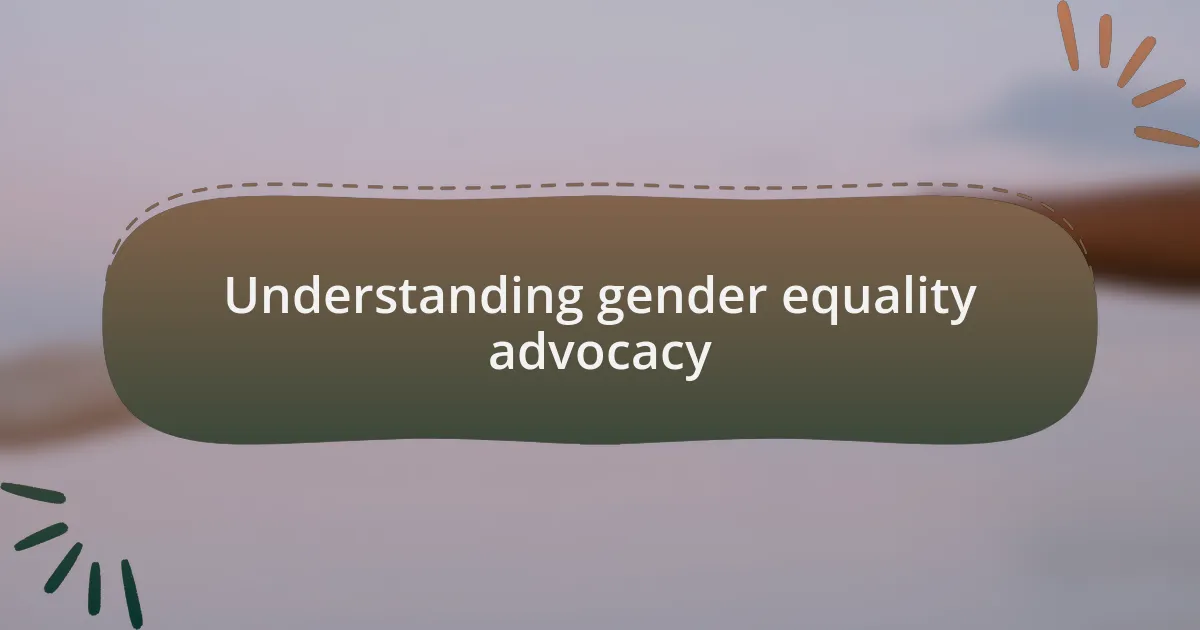
Understanding gender equality advocacy
Gender equality advocacy is about recognizing that each person should have the same rights, opportunities, and access regardless of their gender. I remember a workshop I attended where I heard a powerful story from a woman in her community who fought to break cultural barriers limiting girls’ education. Her experience made me realize just how critical it is to not only advocate for change but to listen to those whose voices have been silenced.
In my journey, I’ve often wondered: what does real equality look like? It’s more than just equal pay; it’s about dismantling systemic biases that have existed for generations. During a discussion, I was struck by a participant who shared her struggles with workplace discrimination. Her courage to speak out illustrated the importance of creating safe spaces for those affected by gender inequality, enabling them to share their stories and build collective strength.
When we advocate for gender equality, we tap into a deeper narrative that affects us all. It’s a process that requires not just understanding policies and frameworks but embodying empathy. I distinctly recall a community event where we brainstormed solutions for supporting survivors of gender-based violence. It was a moment that opened my eyes to the evolution that advocacy demands—it’s about transforming awareness into actionable change.
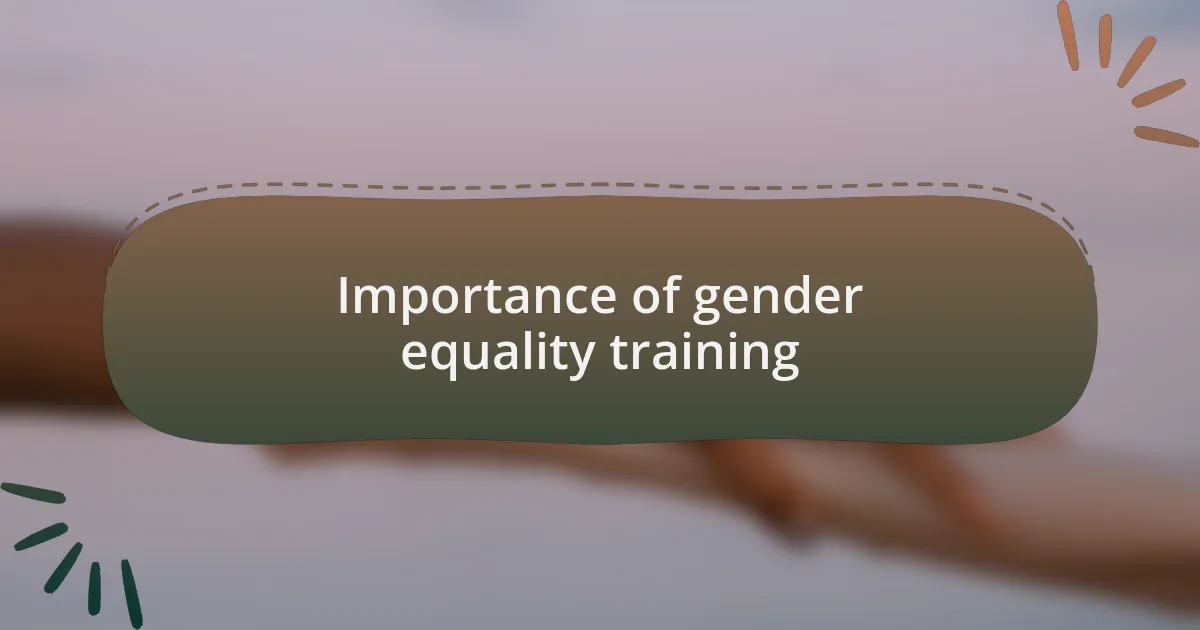
Importance of gender equality training
Gender equality training is vital for fostering an inclusive environment where everyone can thrive. I still remember the first session I attended, where the facilitator broke down unconscious biases in a way that made my heart race. It was a mixture of realization and empowerment—seeing how these biases could affect decision-making in subtle yet profound ways added a personal dimension to a topic I thought I understood.
One striking insight from my training involved addressing microaggressions, those seemingly small comments that can have a huge impact. During our discussions, many shared their experiences of being on the receiving end, and it struck me how a single comment can diminish someone’s voice. I couldn’t help but reflect: if we aren’t aware of our language and actions, how can we expect to build a more equitable space for everyone?
Moreover, gender equality training creates a foundation for effective teamwork and collaboration. I recall a team-building exercise where we simulated decision-making processes; it emphasized the importance of diverse perspectives in achieving well-rounded outcomes. I often ask myself: how can we innovate and grow if we’re not bringing together voices from all walks of life? This training isn’t just about awareness; it’s a transformative experience that can lead to more harmonious and productive workplaces.
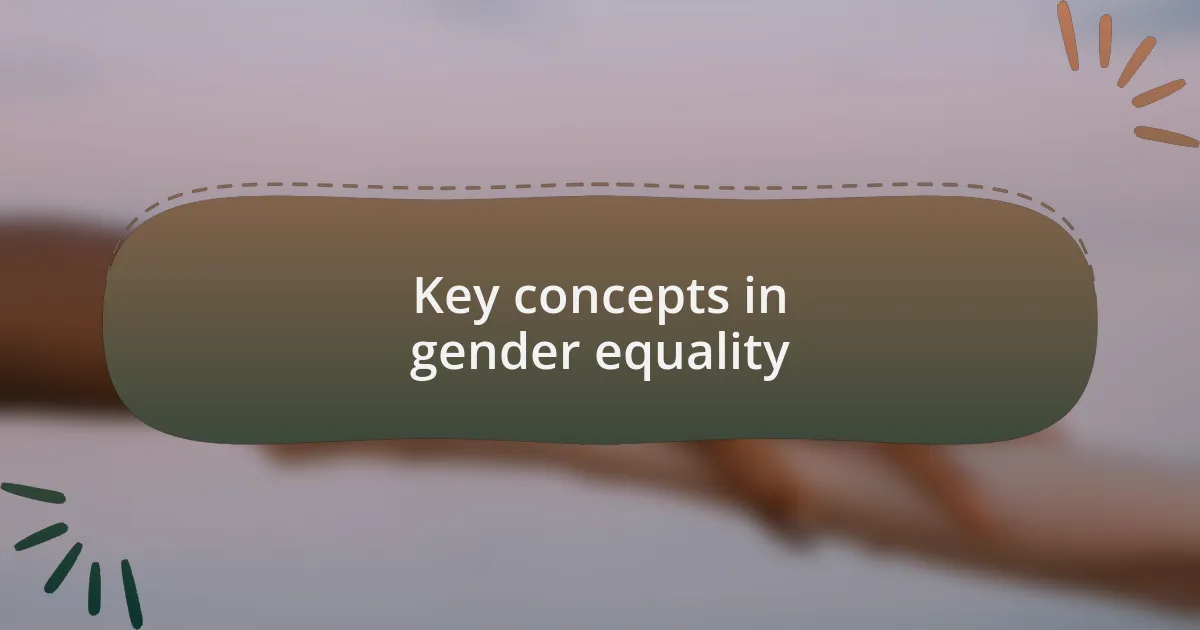
Key concepts in gender equality
Key concepts in gender equality encompass several essential ideas that shape our understanding of this critical issue. One of the fundamental concepts is the notion of equity versus equality. I realized this distinction during a workshop where we explored how providing everyone with the same resources doesn’t account for individual needs. It made me think—what if we tailored our support to address specific barriers? That’s when the idea of equity truly resonated with me.
Another vital concept is intersectionality, which highlights how different social identities, such as race, class, and gender, intersect to create unique experiences of discrimination and privilege. While discussing this at training, I found myself reflecting on my own position within this structure. How often do I consider the multiple facets of my identity when advocating for gender equality? This realization compelled me to think more deeply about the complexity of issues facing marginalized communities.
Additionally, the idea of agency in gender equality training stood out for me. Agency refers to the capacity of individuals to act independently and make choices. In a session about empowerment, I shared my journey of overcoming self-doubt to advocate for others. It was eye-opening to learn how important it is for everyone to feel they have a voice. Truly, if we can help others cultivate their agency, we pave the way for a more just and equitable society.
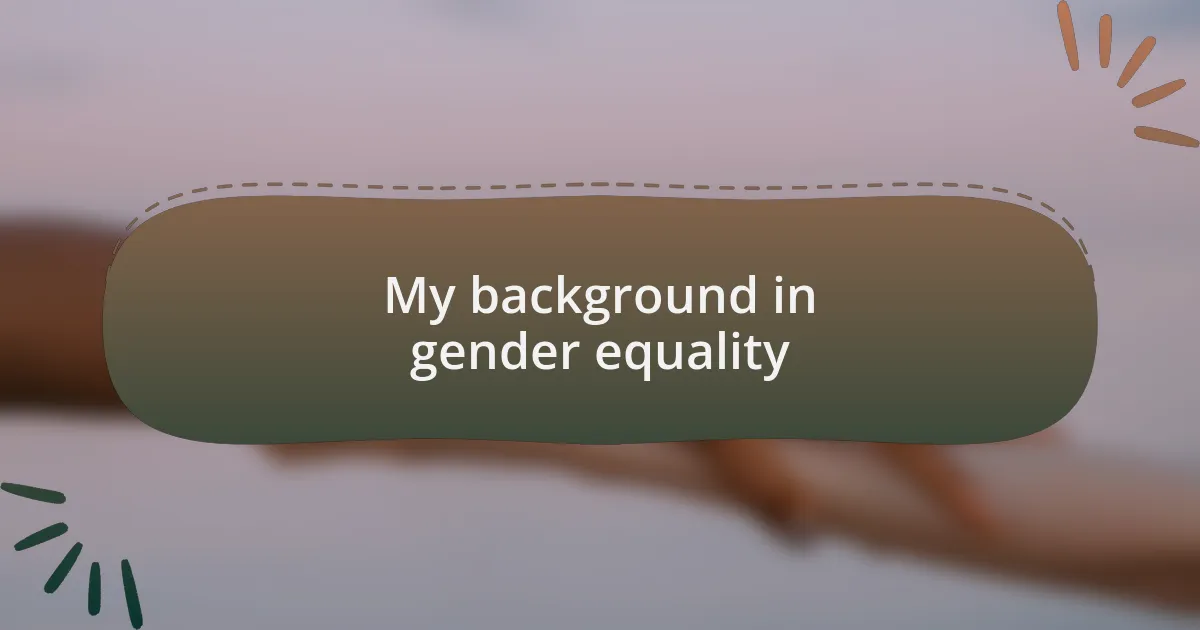
My background in gender equality
In my early days of involvement with gender equality, I took on the role of a volunteer coordinator at a local women’s shelter. This experience opened my eyes to the systemic barriers women face daily, and it became clear to me how crucial it is to advocate for policy changes. I often wondered—how can we empower those who feel voiceless in a world that often overlooks their struggles?
Attending gender equality workshops has profoundly shaped my understanding. One memorable session took place in a room filled with passionate individuals from diverse backgrounds. I vividly recall a moment when someone shared a story about facing discrimination in their workplace. It struck me—how many of us share similar stories, yet feel isolated in our experiences? This shared vulnerability fostered a sense of community and strengthened my resolve to continue this vital work.
Through these journeys, I’ve discovered the importance of listening deeply to the narratives of others. I noticed how my own experiences as a woman shaped my viewpoint, but I realized I couldn’t rely solely on that perspective. Engaging with others has taught me that there’s so much more to learn. Each conversation becomes a stepping stone toward a broader understanding of the nuanced realities of gender equality. It begs the question—how can we truly advocate for one another without recognizing the full tapestry of experiences that exist around us?
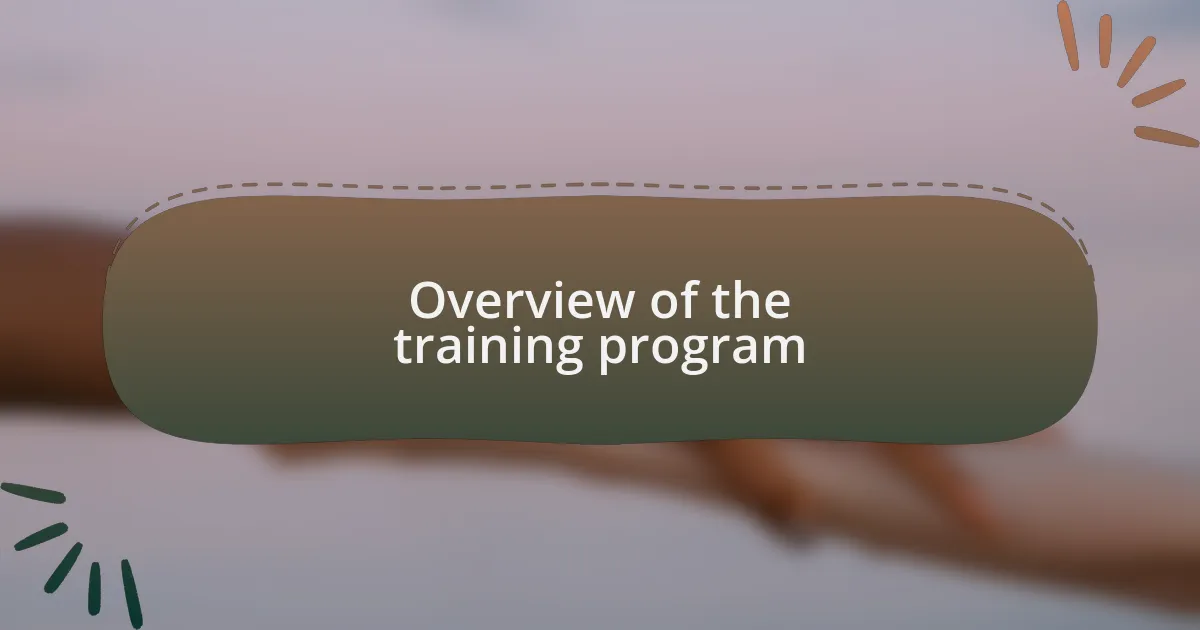
Overview of the training program
The training program I participated in was a blend of theory and practical exercises aimed at fostering a deeper understanding of gender dynamics. I remember sitting in small groups discussing case studies that highlighted real-world scenarios. These discussions allowed me to reflect on my own biases while considering how to approach conversations about gender equality with sensitivity and care.
One of the most impactful components was role-playing exercises that brought theoretical concepts to life. I was tasked with defending a policy initiative aimed at advancing workplace gender parity. It was challenging, yet I felt empowered as I practiced articulating my arguments clearly and confidently. This experience made me question—how often do we prepare ourselves to advocate for change, and what skills do we need to effectively communicate our messages?
Overall, the depth of learning and camaraderie forged in that training program was invaluable. The facilitators encouraged us to share our stories and connect on a personal level, creating a safe space for exploration. Reflecting on these moments, I’m reminded that every conversation about gender equality can plant the seeds for change. Are we ready to nurture those seeds and cultivate a more inclusive environment?
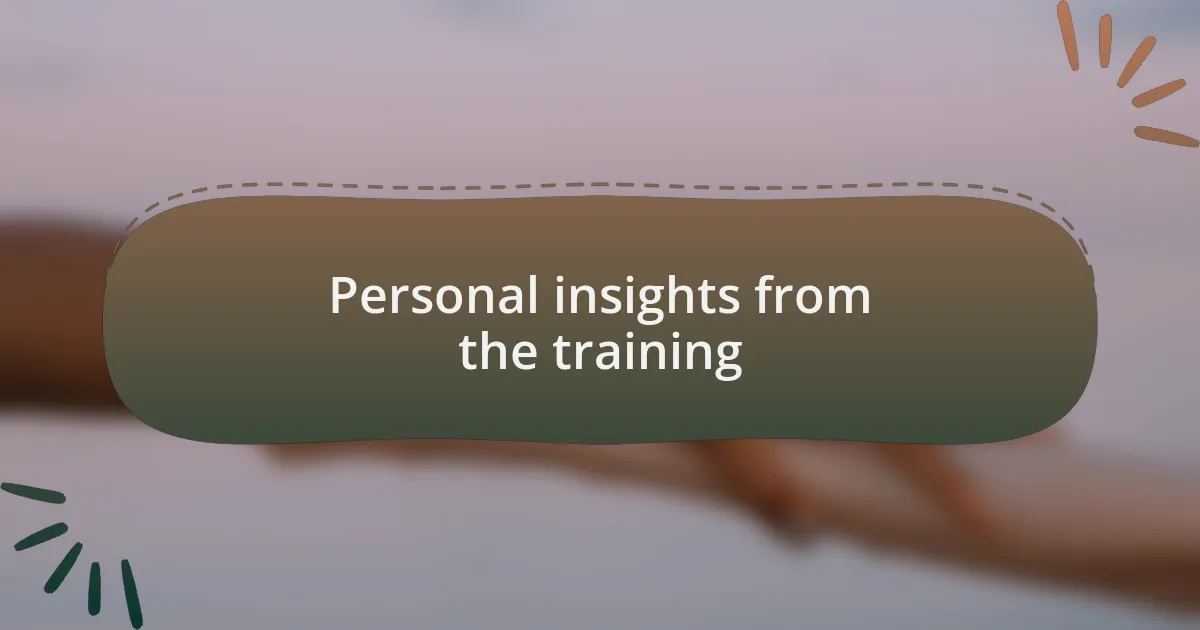
Personal insights from the training
Participating in the training was a transformative experience for me. I recall one particular moment during a brainstorming session when we were asked to envision a future where gender equality was the norm. As we shared our visions, I felt a profound sense of hope and determination. What struck me was how expansive our imaginations could be when we believed change was possible. It made me wonder—how often do we allow ourselves to dream big when tackling complex issues?
In one of the role-playing scenarios, I was tasked with addressing resistance to a gender-inclusive policy. As I navigated through skepticism from the audience, I felt my heart race, but I also discovered my passion for advocacy. The experience taught me that vulnerability can be a powerful tool in conversations. It made me realize that empathy often opens the door to understanding—how can we expect change without first connecting on a human level?
Reflecting on the connections made during the training, I cherish the stories shared by my peers. Each narrative was a reminder of the different journeys we’re all on in the fight for gender equality. Listening to others’ experiences sparked a realization in me: every personal account adds another layer to our collective understanding. How do our individual stories converge to create a stronger narrative for advocacy? That question continues to resonate with me long after the training ended.
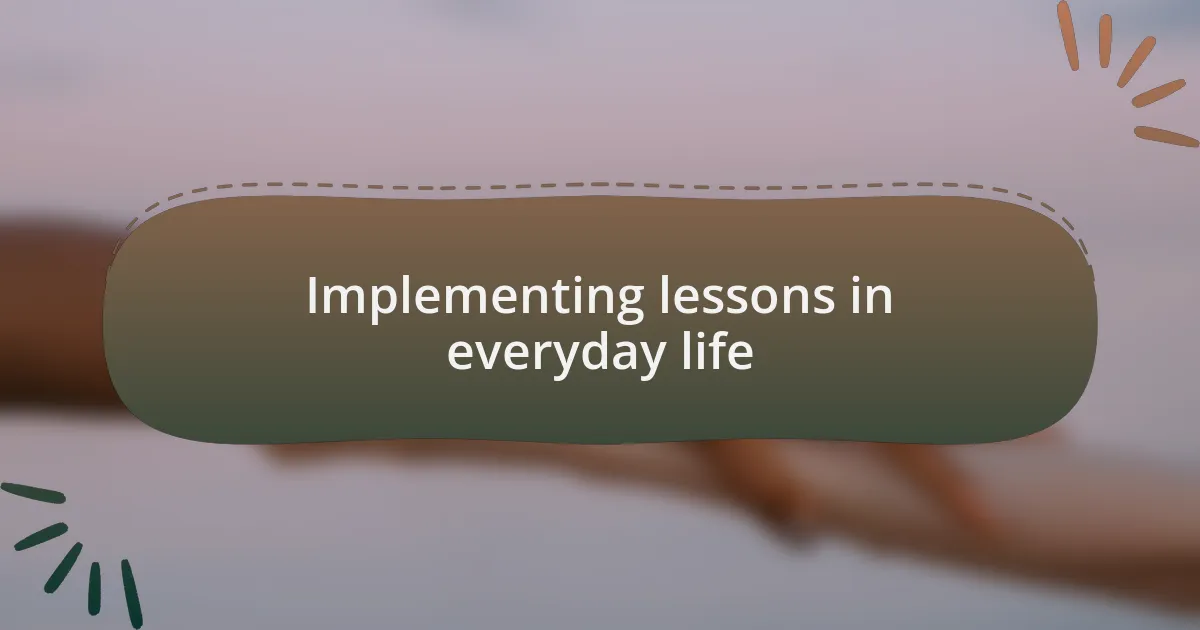
Implementing lessons in everyday life
Implementing lessons from gender equality training into daily life has been essential for me. I started small, consciously examining my language and interactions. For instance, I made an effort to address colleagues, friends, and even family members with inclusive terms. It was surprising how much language can shape perception. Have you ever noticed how your choice of words impacts conversations? It’s powerful to witness.
One significant shift I adopted was actively listening during discussions. I recall a heated meeting where a peer shared their experiences with gender bias. Instead of waiting to respond, I listened intently. That moment was eye-opening; it reminded me of the importance of creating space for others’ voices. Listening fosters an atmosphere of respect—do we sometimes forget that everyone has valuable insights to contribute?
I also began volunteering at local organizations focused on gender equality. Engaging with diverse perspectives not only enriched my understanding but also inspired me to take action. I remember organizing a workshop where participants shared their own gender-based challenges. Seeing their vulnerability reinforced my belief that these conversations matter. How often do we create such safe spaces for dialogue in our own lives? Every small step we take can create a ripple effect, igniting change in our communities.